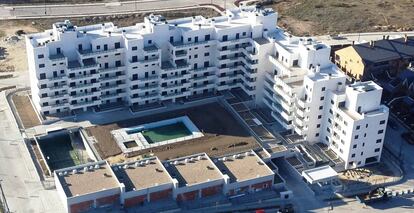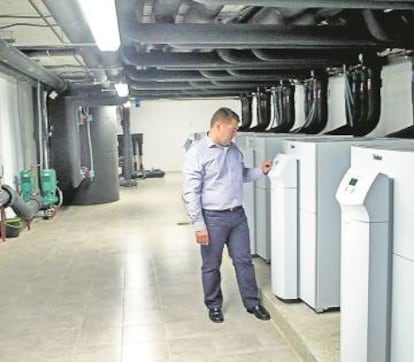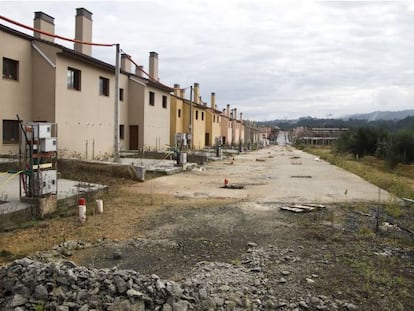Could these Madrid apartments change the way Spain builds?
Award-winning sustainable residential complex offers affordable, energy-efficient homes


The only residential complex in Europe to be given an LEED Platinum certificate, one of the most prestigious sustainable building certifications in the world, is in the Madrid dormitory town of Tres Cantos.
In June, the USGBCI (US Green Building Council Institute) awarded the cooperative of developers behind the project, Arroyo Bodonal, with the international diploma, recognizing its ecological credentials and ushering it into a club of 21 Spanish buildings with LEED certification, including properties owned by multinationals such as Zara, Repsol and Iberdrola, as well as several public buildings and universities.
Consisting of 80 resource-efficient apartments, Arroyo Bodonal was begun 13 years ago and is now inhabited by 225 people, mostly in the 33 to 43 age bracket, who have paid between €127,000 and €350,000 for a home there.
Modestly priced, the project has succeeded in exploding some of the myths surrounding sustainable construction, while reopening the debate over whether building green homes is a viable option in Spain.

Arroyo Bodonal’s pioneering achievement has not been without its complications. With no grants to help the cooperative shoulder extra costs, few believed in the project.
“The costs of putting up this 'A' energy performance certificate building were around 6% or 7% higher than a building with a 'C' energy performance certificate,” says Antonio Martínez Ovejero, one of a group of people who backed the project from the start. He says the project cost some €500,000 more than originally estimated, an additional cost of around €6,000 per homebuyer.
He admits it is a substantial sum, but points out that each home makes a 75.64% energy saving, coupled with a 73.2% drop in carbon dioxide emissions. In comparison to a standard US apartment block, it is 44.6% more energy efficient, says Borja López Calle, a member of the USGBCI, and who obtained the LEED Platinum certificate for the project.
Each year, the building will save around €105,000 on air conditioning, heating and hot water; each household's average monthly electricity bill between May and December last year came to around €37. As Martínez Ovejero points out, the extra €6,000 on the initial cost of each apartment is soon recouped.
The electricity bill per apartment comes to barely €37 a month
“Last summer, the climate control system was enough to cope with the worst heatwave in 30 years, keeping the temperature at between 22ºC and 23ºC in the apartments,” says Martínez Ovejero.
The design of the 80 apartments was inspired by the zero energy consumption guidelines advocated by the EU, which will be obligatory in all new buildings by 2020, meaning it has no diesel or gas boilers or air conditioning units or radiators.
Instead, they have ventilated façades, double insulation and energy efficient glass, under-floor heating and cooling, along with automatic ventilation systems. Each home is also equipped with energy efficient household appliances, as well as bi-thermal washing machines and dishwashers.
Lifts generate energy as they descend, which is stored to help power their ascent. The garage is equipped with recharging points for electric cars, while the complex also collects rainwater as well as reusing water from showers and wash basins for lavatories.
139 buildings give the environment their vote
Up to 139 buildings in Spain have been awarded the LEED certificate since 2008, all of them non-residential buildings, apart from Arroyo Bodonal in Madrid. In the rest of the world some 49,000 buildings have earned LEED status. LEED is not just about energy efficiency, says Borja López of the USGBCI: “The LEED certification rates things such as whether a building is in a zone which is already urbanized and whether it promotes alternative forms of transport such as cycling." It is also considered a plus if the garden areas are resource efficient or if the construction uses local materials, he adds.
But the project nearly ran aground when Spain's economy tanked in 2008. Even before the financial crash, the cooperative found it hard to borrow money from Spain’s banks. “We visited 28 banks asking for a loan,” recalls Martínez. “Only four bothered to study the project and only one – Triodos Bank – took us on, precisely because of the ecological aspect.”
But Arroyo Bodonal has shaken up the building sector in Spain and the rest of Europe by demonstrating that sustainable construction is financially viable. And while it’s not the only residential development in Spain to have been awarded an 'A' energy performance certificate, the others can be counted on the fingers of one hand.
“The first LEED certificate was only awarded to a Spanish building in 2008, coinciding with the downturn in the construction sector,” says Dolores Huerta, technical secretary of the Green Building Council in Spain. “The number of new developments has dropped drastically, which is partly why there are so few with these certificates.”
There are other reasons, however. As Borja López points out, “LEED’s certificates come with stringent conditions. For example, you can’t smoke anywhere in the building. And besides, the property sector doesn’t yet promote sustainability as a guarantee of quality. To get the Platinum LEED certificate requires a real effort that developers of the average home aren’t prepared to make. Arroyo Bodonal is different because it’s a cooperative that had a very clear idea of what it wanted to achieve from the start.”
Meanwhile, Spain’s property developers say buyers are still largely unaware of the benefits of sustainable construction. “There is a lack of knowledge and understanding. Most buyers have no idea what makes a LEED energy rating different from others,” says Fernando Moliner, President of the Commission for Technical Innovation of the Association of Developers in Madrid (Asprima).
Sign up for our newsletter
EL PAÍS English Edition has launched a weekly newsletter. Sign up today to receive a selection of our best stories in your inbox every Saturday morning. For full details about how to subscribe, click here
English version by Heather Galloway.









































